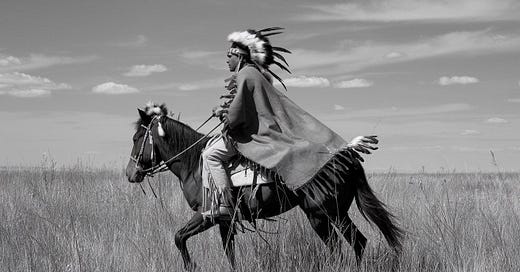Hi all
Today, and again, we're exploring a fascinating intersection of historical perspectives through three poems I have written in the distinctive styles of contemporary masters. Each poem captures a single day in the life of a warrior, yet from three radically different vantage points of American history. Through these varied lenses, we see how personal experience meshes with massive historical movements.
Here is the second poem of the three, with the breakdown of the idea behind it.
A Day’s Circle
This morning I ride where my grandfather’s ghost rides,
through grass that remembers buffalo.
The sun speaks in the old language,
the one my bones know better than my tongue.
My horse and I are one breath,
one thought moving through time
the way a hawk’s shadow travels across earth
without disturbing a single blade of grass.
At the river, I dismount to read what the water writes on stone.
My people’s stories are here:
in the track of elk, in cloud-speak,
in the way wind combs the prairie sage.
I carry my grandfather’s pipe, wrapped in red cloth and prairie wisdom.
When we make camp, I will light it,
let the smoke carry prayers upward while stars arrange themselves
into the shapes of ancient heroes.
The medicine wheel of day turns: morning was a young warrior’s song,
noon spread a feast of light, evening will be crow-wing black.
I am all these moments at once,
carrying yesterday’s dreams into tomorrow’s hunting grounds.
Night comes like a dark blanket woven with stories.
Around the fire, we are time travelers,
my brothers and I, our ancestors, our children yet unborn,
all sharing this single heartbeat of earth.
I have written this in the style of Joy Harjo (b. 1951) - The first Native American U.S. Poet Laureate, whose work frequently addresses indigenous American history and cultural memory. Her collection "An American Sunrise" powerfully explores the Trail of Tears and its lasting impact.
Harjo, as Native American U.S. Poet Laureate, brings a unique perspective to historical poetry through her understanding of time as circular rather than linear. Her work often emphasizes the simultaneity of past, present, and future in Indigenous experience.
Our Sioux brave's day unfolds in Harjo's characteristic spiral of time, where "I am all these moments at once." The poem embraces her frequent themes of ancestral connection ("my grandfather's ghost rides"), spiritual communication with nature ("the sun speaks in the old language"), and the integration of ceremonial practice with daily life. Her influence shows in the poem's treatment of ordinary experiences as sacred and the emphasis on collective rather than individual identity.
I've tried to capture each poet's distinctive voice and approach for each of my three poems, and for this Sioux brave poem, I used Harjo's:
Circular concept of time
Deep connection to nature and ancestors
Spiritual elements woven into everyday observations
Use of natural imagery as metaphor
Integration of ceremonial elements with daily life
These poems remind us that history is not merely a sequence of events, but a complex web of personal experiences, each worthy of examination and understanding. Through the varied styles of three master poets, we gain different ways of seeing and understanding these crucial moments in American history.
Next week, we'll complete our trio of war poems with a study of a British soldier on the eve of a battle during the American War of Independence.
Until then, keep reading, keep writing, and keep exploring the power of poetry to illuminate both past and present.
Best regards,
Tom Kane
Editor, Poetry Genius
---
Subscribe to Poetry Genius for monthly dips into contemporary poetry, craft discussions, and analysis of both classic and modern works.







Thank you Mary, appreciated.